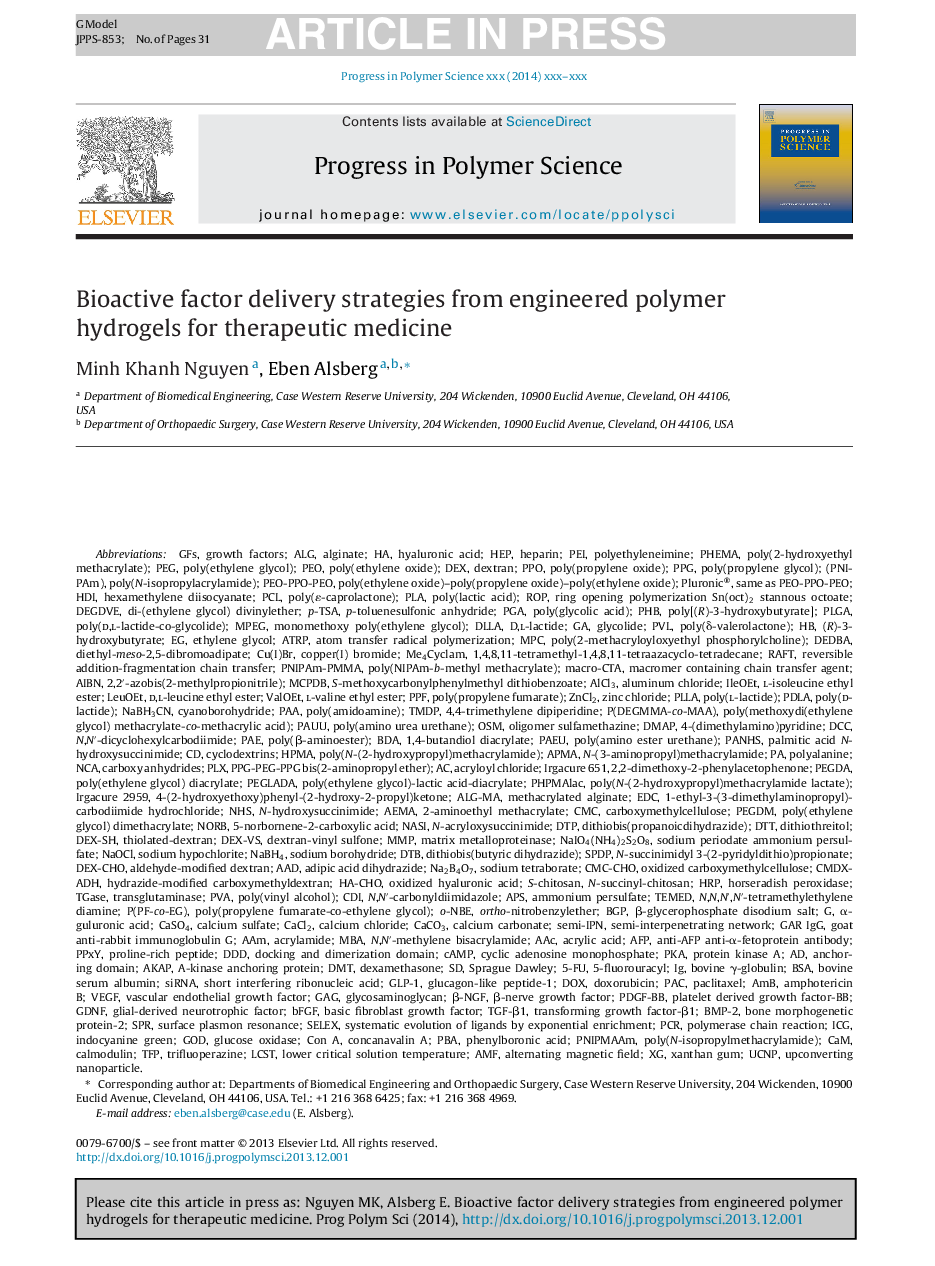| Article ID | Journal | Published Year | Pages | File Type |
|---|---|---|---|---|
| 5208149 | Progress in Polymer Science | 2014 | 31 Pages |
Abstract
Polymer hydrogels have been widely explored as therapeutic delivery matrices because of their ability to present sustained, localized and controlled release of bioactive factors. Bioactive factor delivery from injectable biopolymer hydrogels provides a versatile approach to treat a wide variety of diseases, to direct cell function and to enhance tissue regeneration. The innovative development and modification of both natural- (e.g., alginate (ALG), chitosan, hyaluronic acid (HA), gelatin, heparin (HEP), etc.) and synthetic- (e.g., polyesters, polyethyleneimine (PEI), etc.) based polymers has resulted in a variety of approaches to design drug delivery hydrogel systems from which loaded therapeutics are released. This review presents the state-of-the-art in a wide range of hydrogels that are formed though self-assembly of polymers and peptides, chemical crosslinking, ionic crosslinking and biomolecule recognition. Hydrogel design for bioactive factor delivery is the focus of the first section. The second section then thoroughly discusses release strategies of payloads from hydrogels for therapeutic medicine, such as physical incorporation, covalent tethering, affinity interactions, on demand release and/or use of hybrid polymer scaffolds, with an emphasis on the last 5 years.
Keywords
PEIPVAPLGAMMP5-FUDEXCMCPGAPCLEDCCaCl2MPCNaBH4PPFATRPPHBCDIPAAOSMDMAPPLADTTAADCaCO3BGPHRPmPEGALGPPOAACDMTpKaBDADDDNHSDCCROPSPDPAlCl3PAEHDIPLLAHEPGFSMBATEMEDPPGAAMNCAAKAPN-hydroxysuccinimidepHEMAAIBNDTBZnCl2N-succinyl-chitosanPluronic®TGasePDLACaSO4HPMAAEMAPoly(d-lactide)2,2′-Azobis(2-methylpropionitrile)2,2-Dimethoxy-2-phenylacetophenoneNaBH3CNhexamethylene diisocyanatep-TSANaOClDTPd,l-LactideCopper(I) bromideNaSiN-acryloxysuccinimidePEO-PPO-PEOSodium tetraborateAPMAN,N′-Methylene bisacrylamideN,N′-carbonyldiimidazoleN-succinimidyl 3-(2-pyridyldithio)propionate1-ethyl-3-(3-dimethylaminopropyl)-carbodiimide hydrochloride4-(Dimethylamino)pyridineAPsBSAcAMPN,N′-dicyclohexylcarbodiimidesiRNACyclic adenosine monophosphatebovine serum albuminAlginateAcrylamideEthylene glycolSprague DawleyHyaluronic acidAtom transfer radical polymerizationReversible addition-fragmentation chain transferAcrylic acidSodium borohydrideTransglutaminaseAFPDextranDexamethasoneAdipic acid dihydrazidedithiothreitolRAFTSodium hypochloriteCalcium sulfatecyclodextrinsSemi-interpenetrating networkGrowth factorsmatrix metalloproteinasePVLSemi-IPNHeparinHorseradish peroxidaseammonium persulfateA-kinase anchoring proteinprotein kinase APoly(2-methacryloyloxyethyl phosphorylcholine)poly(2-hydroxyethyl methacrylate)Poly(d,l-lactide-co-glycolide)Poly(l-lactide)Poly(N-isopropylacrylamide)Poly(ɛ-caprolactone)poly(glycolic acid)Poly(propylene oxide)Poly(lactic acid)Poly(propylene fumarate)Poly(propylene glycol)Poly[(R)-3-hydroxybutyrate]Polyalaninepoly(amidoamine)poly(ethylene oxide)Poly(ethylene glycol)Poly(ethylene glycol) diacrylatePoly(ethylene glycol) dimethacrylatepolyethyleneiminePoly(vinyl alcohol)PEGProline-rich peptidePEGDAPEOCalcium carbonatecarboxymethylcelluloseAluminum chlorideAcryloyl chloridezinc chlorideCalcium chlorideGlycolide
Related Topics
Physical Sciences and Engineering
Chemistry
Organic Chemistry
Authors
Minh Khanh Nguyen, Eben Alsberg,
